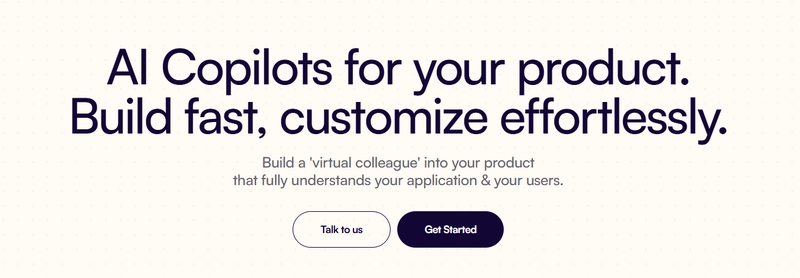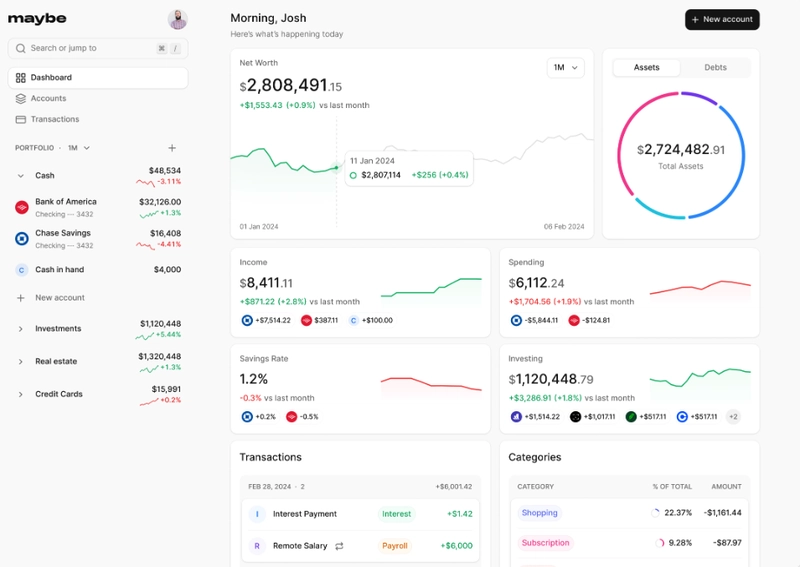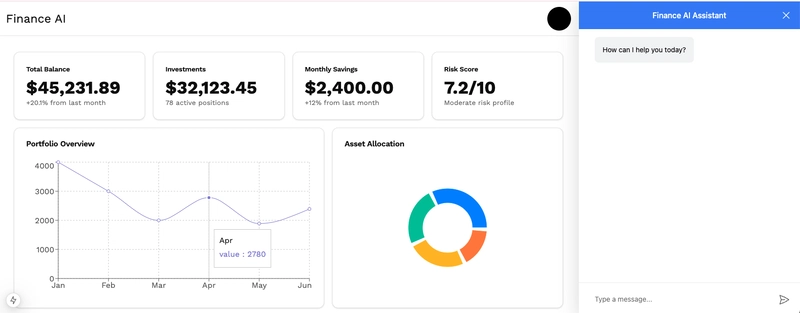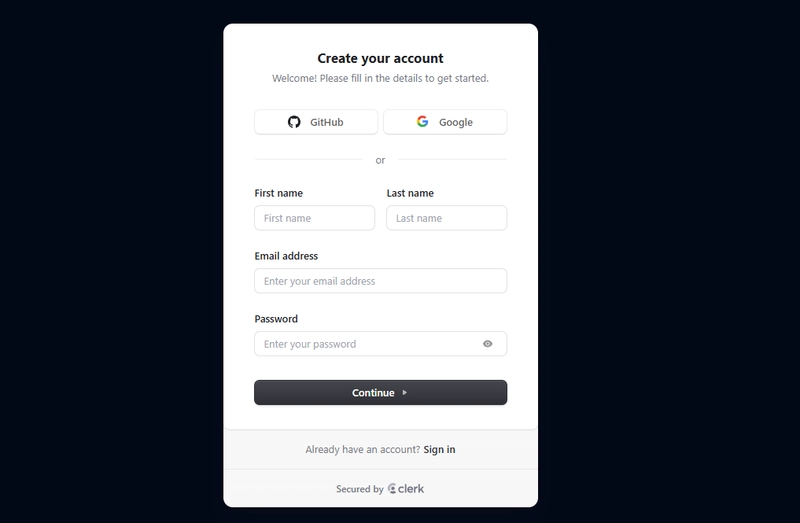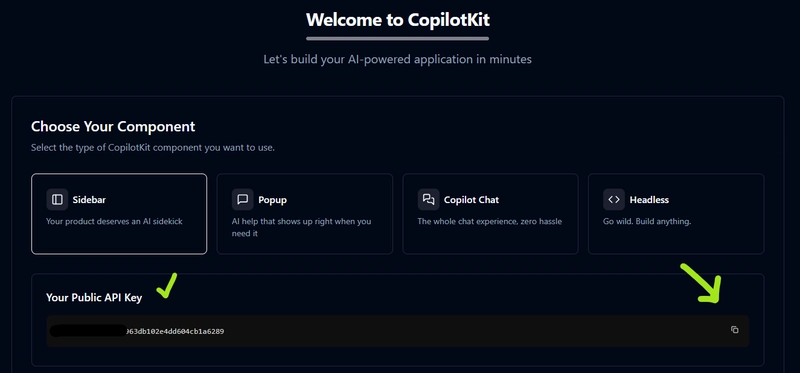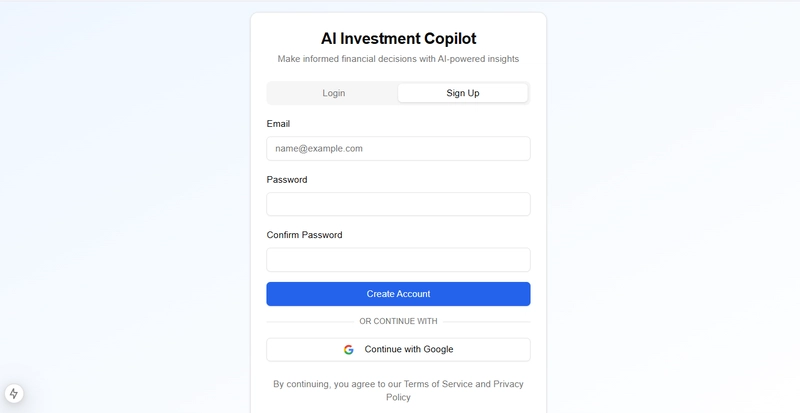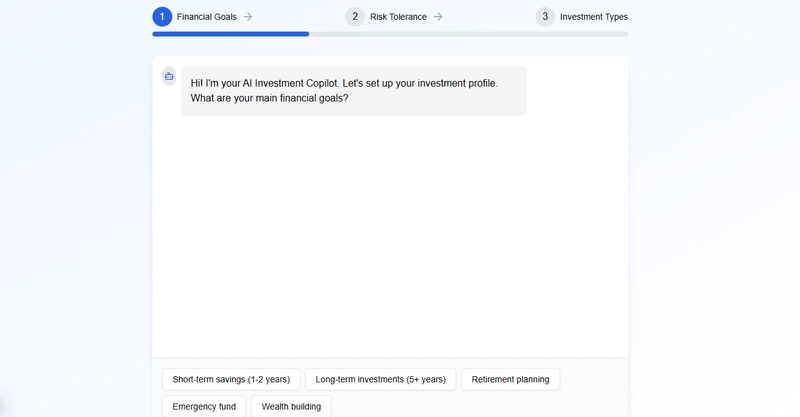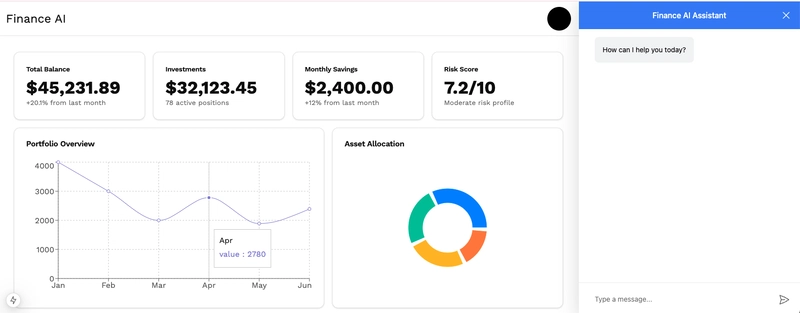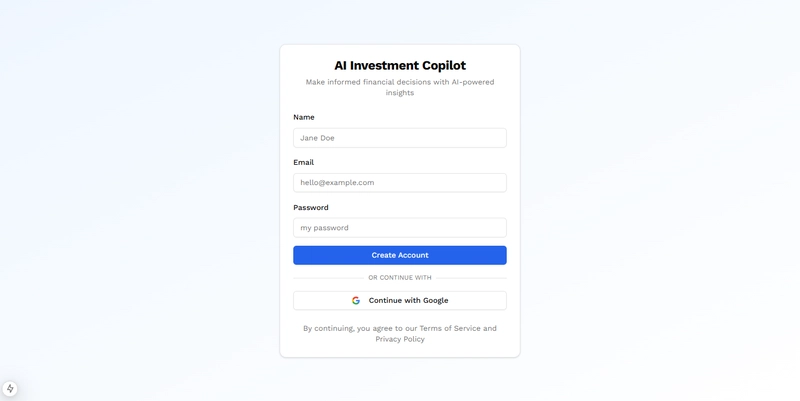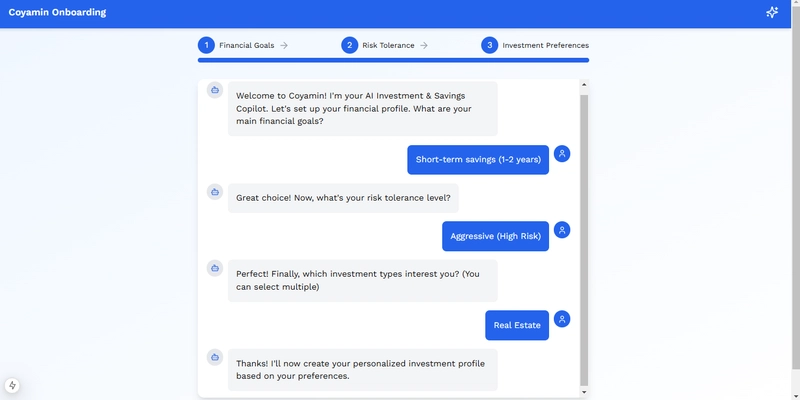如何使用 Maybe Finance 和 CopilotKit 构建一个由 AI 驱动的开源财务管理器⚡️
TL;DR
在本教程中,我们将引导您逐步构建由AI 驱动的投资和储蓄 Copilot ,以帮助您使用Maybe Finance、Nextjs 和CopilotKit 🪁规划储蓄和投资。
以下是我们将要介绍的内容:
- 为 AI Investment & Savings Copilot 构建 Next.js 项目。
- 将 CopilotKit UI 组件和 API 端点添加到您的应用。
- 集成 Maybe Finance API 以提供个性化的投资和储蓄见解。
以下是人工智能金融应用程序实施的预览:
让我们开始吧!
CopilotKit 是什么
CopilotKit 是一个用于构建用户交互代理和副驾驶的全栈框架。它为代理提供了使用应用程序的工具,并提供了一个 功能丰富的 SDK ,支持各种 AI 副驾驶用例,包括 情境感知、 副驾驶操作和 生成式 UI。
这使您可以定义副驾驶的角色,而无需处理复杂的设置或集成。
Maybe Finance 是什么?
Maybe Finance是个人理财的开源操作系统,提供安全管理、规划和优化您的储蓄和投资的工具。
在我们的项目中,我们将利用 Maybe Finance 的实时数据和分析来增强我们的副驾驶的洞察力,帮助用户优化他们的储蓄和投资。
先决条件
在开始之前,请确保您已:
技术知识
- 对 Next.js 和 React 有中级理解
- TypeScript 基础知识
- 熟悉 MongoDB
所需帐户
- CopilotKit Cloud获取 AI 助手的 API 密钥
- SynthFinance访问Maybe Finance API
- 用于数据库托管的 MongoDB Atlas
- 用于 OAuth 身份验证的 Google Cloud Platform 帐户
开发环境
- Node.js 18+ 和 npm
- 代码编辑器(推荐使用 VS Code)
一旦你解决了这个问题,我们就会开始开发!🚀
这是我们将要构建的 Web 应用程序
设置项目
1.创建一个新的 Next.js 项目
打开终端并运行此命令来创建一个新的 Next.js 项目
npx create-next-app@latest finance_ai --typescript
导航到项目目录并启动开发服务器:
cd finance_ai
npm run dev
您的应用程序现在应该在http://localhost:3000上运行。
2.安装软件包
接下来,让我们安装该项目所需的依赖项。这些包括:
- CopilotKit 包。
- Axios(用于获取 API)
- Shadcn/ui(用于预构建的 UI 组件)
- Recharts(用于图表表示)
运行以下命令来安装它们:
npm install @copilotkit/react-ui @copilotkit/react-core axios
然后,对于 Shadcn UI,运行此命令
npx shadcn@latest add button card input label badge tabs
注意:如果您使用的是 CopilotKit Cloud,则无需包含运行时包,因为 CopilotKit Cloud 会自动管理运行时环境。但是,如果您自行托管后端,则可能需要手动处理运行时配置。在本教程中,我们将重点介绍自行托管,但请记住,CopilotKit Cloud 是一个可以简化运行时管理的选项。
现在,让我们设置项目结构。我们将创建的关键文件和目录包括:
src/app/ui/service/index.ts– 处理 API 调用以获取财务数据。src/app/ui/components/FinanceCopilot.tsx– 我们人工智能财务助理的主要 UI 组件。src/app/lib/types/investment.ts– 为投资和储蓄数据定义 TypeScript 类型。src/app/lib/data/mockData.ts– 包含用于测试的财务数据。src/app/api/copilotkit/route.ts– CopilotKit 的 API 端点。src/app/api/finance/route.ts– 用于获取财务见解的 API。
项目结构
下面是我们的应用程序的文件树:
构建金融AI前端
1. 设置全球供应商layout.tsx
首先,请访问cloud.copilotkit.ai获取您的 CopilotKit Cloud 密钥,用于身份验证和 API 访问。您可以使用 GitHub 或 Google 注册。
然后,复制您的 API 密钥并将其保存到您的.env文件中。然后,更新您的全局布局,使用 CopilotKit 提供程序包装您的应用。这样,Copilot 功能便可在整个应用中使用。
现在已设置完毕,在此目录中输入以下代码finance_ai/app/layout.tsx
import { Metadata } from "next";
import { Geist, Geist_Mono } from "next/font/google";
import "./globals.css";
import { CopilotKit } from "@copilotkit/react-core";
import "@copilotkit/react-ui/styles.css";
// Load fonts for styling
const geistSans = Geist({
variable: "--font-geist-sans",
subsets: ["latin"],
});
const geistMono = Geist_Mono({
variable: "--font-geist-mono",
subsets: ["latin"],
});
// Metadata for SEO and display
export const metadata: Metadata = {
title: "Coyamin - AI Investment Copilot",
description: "Make informed financial decisions with AI-powered insights.",
};
// Retrieve the Copilot API key from environment variables
const copilotApiKey = process.env.NEXT_PUBLIC_COPILOTKIT_API_KEY;
export default function RootLayout({
children,
}: Readonly<{ children: React.ReactNode }>) {
return (
<html lang="en">
<body className={`${geistSans.variable} ${geistMono.variable} antialiased`}>
{/* Conditionally wrap with CopilotKit if the API key is available */}
{copilotApiKey ? (
<CopilotKit publicApiKey={copilotApiKey}>{children}</CopilotKit>
) : (
<>{children}</>
)}
</body>
</html>
);
}
在上面的代码中,我们首先导入全局样式和字体,确保整个应用程序的设计一致。
接下来,我们将应用程序与CopilotKit提供商一起包装以使用 API 密钥;<CopilotKitProvider apiKey={process.env.NEXT_PUBLIC_COPILOTKIT_API_KEY}><App /> </CopilotKitProvider>
此设置使得 AI 功能可在应用程序的所有组件中访问。
2. 创建登录和入门屏幕
要创建登录表单组件,请在中输入以下代码app/api/auth/[...nextauth]/route.ts:
import NextAuth from "next-auth";
import GoogleProvider from "next-auth/providers/google";
import { PrismaAdapter } from "@auth/prisma-adapter";
import { prisma } from "@/lib/db";
export const authOptions = {
adapter: PrismaAdapter(prisma),
providers: [
GoogleProvider({
clientId: process.env.GOOGLE_CLIENT_ID as string,
clientSecret: process.env.GOOGLE_CLIENT_SECRET as string,
}),
],
callbacks: {
async session({ session, user }) {
if (session?.user) {
session.user.id = user.id;
session.user.isOnboarded = user.isOnboarded;
}
return session;
},
},
pages: {
signIn: "/",
},
};
const handler = NextAuth(authOptions);
export { handler as GET, handler as POST };
身份验证页面分为两个选项卡:登录和注册。每个表单都使用带标签的输入字段和一个按钮,该按钮在身份验证成功后会重定向到入门页面。
入职页面
入职页面有一个聊天界面,作为入职流程的一部分,它会询问财务目标、风险承受能力和投资偏好等问题。
在app/onboarding目录中,创建一个page.tsx文件并输入以下代码:
"use client"
import { useState, useEffect } from "react"
import { useRouter } from "next/navigation"
import { Button } from "@/components/ui/button"
import { Card, CardContent } from "@/components/ui/card"
import { Badge } from "@/components/ui/badge"
import { ArrowRight, Bot, User, Sparkles } from "lucide-react"
interface Message {
type: "bot" | "user"
content: string
options?: string[]
}
export default function OnboardingChat() {
const router = useRouter()
const [messages, setMessages] = useState<Message[]>([
{
type: "bot",
content: "Welcome to Coyamin! I'm your AI Investment & Savings Copilot. Let's set up your financial profile. What are your main financial goals?",
options: [
"Short-term savings (1-2 years)",
"Long-term investments (5+ years)",
"Retirement planning",
"Emergency fund",
"Wealth building",
],
},
])
const [currentStep, setCurrentStep] = useState(0)
const [selectedOptions, setSelectedOptions] = useState<Record<number, string[]>>({})
在这里,我们导入 Shadcn UI 按钮、卡片和徽章组件,并添加状态管理,import { useState, useEffect } from "react".我们还包含一个OnboardingChat()带有消息的功能来欢迎用户并询问他们的财务目标,他们可以从选项中进行选择,如下所示:
处理用户选择和聊天流程
当您选择一个选项时,聊天机器人会动态响应并逐步引导您完成不同的入职阶段。我们还提供了一个下拉菜单,用于解释每个风险承受等级:
// Define the steps of the onboarding process
const steps = [
{ title: "Financial Goals", progress: 33 },
{ title: "Risk Tolerance", progress: 66 },
{ title: "Investment Preferences", progress: 100 },
];
const handleOptionSelect = (option: string) => {
setMessages((prev) => [...prev, { type: "user", content: option }]);
setSelectedOptions((prev) => ({
...prev,
[currentStep]: [...(prev[currentStep] || []), option],
}));
setTimeout(() => {
if (currentStep === 0) {
setMessages((prev) => [
...prev,
{
type: "bot",
content: "Great choice! Now, what's your risk tolerance level?",
options: ["Conservative (Low Risk)", "Moderate (Medium Risk)", "Aggressive (High Risk)"],
},
]);
setCurrentStep(1);
} else if (currentStep === 1) {
setMessages((prev) => [
...prev,
{
type: "bot",
content: "Perfect! Finally, which investment types interest you? (You can select multiple)",
options: ["Stocks", "ETFs", "Bonds", "Crypto", "Real Estate", "Mutual Funds"],
},
]);
setCurrentStep(2);
} else if (currentStep === 2) {
setMessages((prev) => [
...prev,
{
type: "bot",
content: "Thanks! I'll now create your personalized investment profile based on your preferences.",
},
]);
setTimeout(() => {
router.push("/dashboard");
}, 1500);
}
}, 500);
};
3.创建仪表板
仪表板显示财务概览和 AI 生成的建议。请在app/dashboard/page.tsx
将仪表板包装器与 CopilotKit 侧边栏集成,
这会将整个仪表板与CopilotSidebar组件包装在一起,并为仪表板内容设置主弹性容器。
"use client"
import { CopilotSidebar } from "@copilotkit/react-ui";
export default function DashboardPage() {
return (
<CopilotSidebar
defaultOpen={true}
instructions="You are assisting the user as best as you can. Answer in the best way possible given the data you have."
labels={{
title: "Coyamin Assistant",
initial: "How can I help you today?",
}}
>
{/* Main container: fills the available viewport height */}
<div className="flex h-[calc(100vh-3.5rem)]">
<div className="flex-1 p-4 sm:p-6 lg:p-8 overflow-auto">
{/* Dashboard content goes here */}
</div>
</div>
</CopilotSidebar>
);
}
提供CopilotSidebar持久的 AI 聊天界面,而弹性容器(div带有flex h-[calc(100vh-3.5rem)])确保仪表板占据视口的整个高度减去标题偏移量。
此外,内部容器(<div className="flex-1 p-4 sm:p-6 lg:p-8 overflow-auto">)有填充且可滚动,可用于容纳概览和图表组件。
在仪表板中实现概览卡
仪表板的“概览”部分定义了一个卡片网格,每个卡片显示一个关键的财务指标,例如总余额、投资、每月储蓄和风险评分。
仍在page.tsx文件中,输入以下代码
<div className="grid gap-4 sm:grid-cols-2 lg:grid-cols-4">
<Card>
<CardHeader className="flex flex-row items-center justify-between space-y-0 pb-2">
<CardTitle className="text-sm font-medium">Total Balance</CardTitle>
</CardHeader>
<CardContent>
<div className="text-xl sm:text-2xl font-bold">$45,231.89</div>
<p className="text-xs sm:text-sm text-muted-foreground">+20.1% from last month</p>
</CardContent>
</Card>
<Card>
<CardHeader className="flex flex-row items-center justify-between space-y-0 pb-2">
<CardTitle className="text-sm font-medium">Investments</CardTitle>
</CardHeader>
<CardContent>
<div className="text-xl sm:text-2xl font-bold">$32,123.45</div>
<p className="text-xs sm:text-sm text-muted-foreground">78 active positions</p>
</CardContent>
</Card>
<Card>
<CardHeader className="flex flex-row items-center justify-between space-y-0 pb-2">
<CardTitle className="text-sm font-medium">Monthly Savings</CardTitle>
</CardHeader>
<CardContent>
<div className="text-xl sm:text-2xl font-bold">$2,400.00</div>
<p className="text-xs sm:text-sm text-muted-foreground">+12% from last month</p>
</CardContent>
</Card>
<Card>
<CardHeader className="flex flex-row items-center justify-between space-y-0 pb-2">
<CardTitle className="text-sm font-medium">Risk Score</CardTitle>
</CardHeader>
<CardContent>
<div className="text-xl sm:text-2xl font-bold">7.2/10</div>
<p className="text-xs sm:text-sm text-muted-foreground">Moderate risk profile</p>
</CardContent>
</Card>
</div>
每个卡片都由标签的标题(和)和指标值及描述的内容( )Card组成。网格布局()是为了确保卡片间距均匀且响应迅速。CardHeaderCardTitleCardContentgrid gap-4 sm:grid-cols-2 lg:grid-cols-4
使用 Rechart 添加图表
我们使用 Recharts 在应用程序中创建两种类型的图表:用于投资组合概览的折线图和用于资产配置的饼图。这些图表旨在清晰地呈现财务趋势和资产分布。有关 Recharts 的更多详细信息,请参阅Recharts 文档。
运行此命令来安装 Recharts:
npm install recharts
然后将此代码添加到page.tsx仪表板目录中的文件中:
import {
LineChart,
Line,
XAxis,
YAxis,
CartesianGrid,
Tooltip,
ResponsiveContainer,
PieChart,
Pie,
Cell,
} from "recharts";
const chartData = [
{ name: "Jan", value: 4000 },
{ name: "Feb", value: 3000 },
{ name: "Mar", value: 2000 },
{ name: "Apr", value: 2780 },
{ name: "May", value: 1890 },
{ name: "Jun", value: 2390 },
];
const pieData = [
{ name: "Stocks", value: 400 },
{ name: "Bonds", value: 300 },
{ name: "Real Estate", value: 300 },
{ name: "Crypto", value: 200 },
];
const COLORS = ["#0088FE", "#00C49F", "#FFBB28", "#FF8042"];
export default function ChartsSection() {
return (
<div className="grid gap-4 sm:grid-cols-1 md:grid-cols-2 lg:grid-cols-7 mt-4">
{/* Portfolio Overview - Line Chart */}
<div className="col-span-1 md:col-span-2 lg:col-span-4">
<div className="border rounded shadow p-4">
<h3 className="text-lg font-semibold mb-2">Portfolio Overview</h3>
<ResponsiveContainer width="100%" height="250px">
<LineChart data={chartData}>
<CartesianGrid strokeDasharray="3 3" />
<XAxis dataKey="name" />
<YAxis />
<Tooltip />
<Line type="monotone" dataKey="value" stroke="#8884d8" />
</LineChart>
</ResponsiveContainer>
</div>
</div>
{/* Asset Allocation - Pie Chart */}
<div className="col-span-1 md:col-span-2 lg:col-span-3">
<div className="border rounded shadow p-4">
<h3 className="text-lg font-semibold mb-2">Asset Allocation</h3>
<ResponsiveContainer width="100%" height="250px">
<PieChart>
<Pie data={pieData} innerRadius={50} outerRadius={80} paddingAngle={5} dataKey="value">
{pieData.map((entry, index) => (
<Cell key={`cell-${index}`} fill={COLORS[index % COLORS.length]} />
))}
</Pie>
<Tooltip />
</PieChart>
</ResponsiveContainer>
</div>
</div>
</div>
);
}
在上面的代码中,折线图(投资组合概览)使用ResponsiveContainer来确保图表完全响应。该LineChart组件使用 来绘制数据以CartesianGrid供视觉参考,而XAxis和 则YAxis提供标签以提高可读性。以这种模块化方式使用 Recharts 可以使代码保持清晰易维护。
然后,更新pages/index.tsx以在主应用程序中显示仪表板。
import Dashboard from '../components/Dashboard';
export default function Home() {
return (
<main className="min-h-screen bg-gray-100 p-10">
<Dashboard />
</main>
);
}
4.设置后端端点
CopilotKit 端点
在 中pages/api/copilotkit.ts,设置后端端点以处理来自 Copilot UI 的请求。此端点会将请求转发到我们的 AI 引擎(并与 Maybe Finance 交互):
import { NextApiRequest, NextApiResponse } from 'next';
import { copilotRuntimeNextJSAppRouterEndpoint } from '@copilotkit/runtime';
或许金融 API 端点
现在,让我们将 Maybe Finance 与 Coyamin 应用程序集成。我们将创建多个 API 路由,作为前端和 Maybe Finance API 之间的安全中介。
首先,设置环境变量来存储我们的 API 凭证:
API_KEY=your_maybe_finance_api_key
BASE_URL=https://api.synthfinance.com
我们将创建一系列 API 路由,作为我们的财务数据管道。每条路由将处理特定类型的财务数据:
货币信息 API
用于获取聊天过程中所需的各种货币信息。请route.ts在目录中创建一个文件app/api/rates/live:
import { NextResponse } from "next/server";
import axios from "axios";
const API_KEY = process.env.API_KEY;
const BASE_URL = process.env.BASE_URL;
export async function GET(req: Request) {
try {
const { searchParams } = new URL(req.url);
const to = searchParams.get("to");
if (!to) {
return NextResponse.json(
{ message: "Missing required query parameter: to" },
{ status: 400 }
);
}
const response = await axios.get(`${BASE_URL}/rates/live`, {
params: { to },
headers: {
Authorization: `Bearer ${API_KEY}`,
Accept: "application/json",
},
});
return NextResponse.json(response.data, { status: 200 });
} catch (error: unknown) {
if(error instanceof Error) {
return NextResponse.json(
{ message: "Error fetching live rates", error: error.message },
{ status: 500 }
);
}
return NextResponse.json(
{ message: "Error fetching live rates"},
{ status: 500 }
);
}
}
此端点允许您查看货币价值和投资机会如何随时间变化,以便做出数据驱动的决策。
5.运行应用程序
启动你的开发服务器:
npm run dev
在浏览器中打开http://localhost:3000。您应该会看到带有 Copilot 侧边栏的仪表板。登录后,完成新手入门聊天,然后与 Copilot 进行交互,即可获取由 CopilotKit 和 Maybe Finance 提供支持的财务洞察。
注册页面
入职
最终成果是一个使用 CopilotKit 功能齐全的 AI 驱动财务应用程序:
要从GitHub克隆项目并在本地运行,请打开终端并运行以下命令:
git clone https://github.com/Tabintel/finance_ai.git
然后运行npm install以安装项目所需的所有依赖项并npm run dev运行 Web 应用程序。
概括
在本指南中,我们介绍了使用CopilotKit和Maybe Finance构建 AI 驱动的投资和储蓄 Copilot 的过程,以帮助用户有效地规划他们的财务。
虽然我们已经介绍了主要功能,但这仅仅是个开始 - CopilotKit 支持无数由 AI 驱动的用例,从个性化财务助理到金融科技应用程序中的智能自动化。
点击此处查看 GitHub 上的完整源代码
在Twitter上关注 CopilotKit并打招呼,如果您想构建一些很酷的东西,请加入Discord社区。
文章来源:https://dev.to/copilotkit/how-to-build-an-ai-powered-open-source-financial-manager-using-maybe-finance-copilotkit-4441 后端开发教程 - Java、Spring Boot 实战 - msg200.com
后端开发教程 - Java、Spring Boot 实战 - msg200.com

